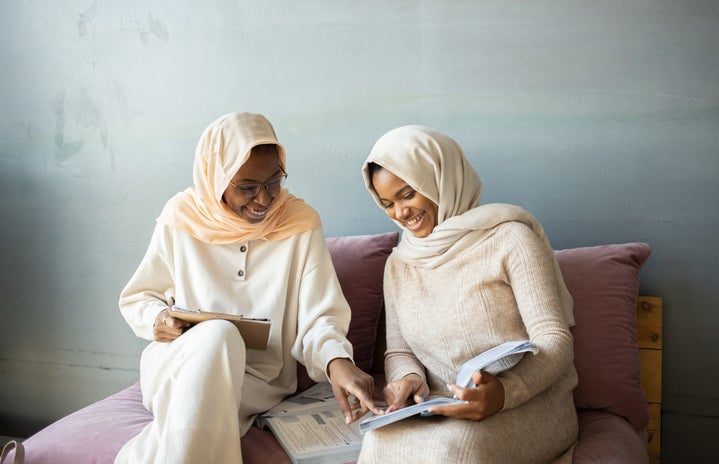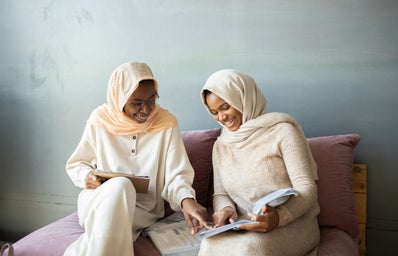As seasons change, so do trends in the fashion and beauty industry. Micro and macro trends are dominating the digital fashion landscape and new styles are constantly being created, repurposed and circulated online. This rapid trendsetting, although positive in introducing new textiles, patterns and ways to express oneself, can also bring controversy.
In recent winter months, the fashion community has seen a variety of new and trendy winter clothes online and in stores. Well-known brands and low-key, indie labels have come out with new winter silhouettes in the hopes of replacing traditional looks with more high-fashion styles. This is when balaclavas entered the landscape of mainstream fashion media.
Balaclavas are head accessories used to protect the neck and sometimes parts of the face from cold temperatures. Commonly known as a “face covering” or a “ski mask,” variations of this trendy accessory resemble the hijab, a symbolic and religious headscarf worn by females in Muslim cultures.
Throughout history, hijabs and their religious symbolism have been key to the Muslim identity. It represents one’s loyalty to their religious practices and encourages modest values. It is a lifestyle, a lineage, a connection to one’s past and culture, and it carries personalized meanings to each of its wearers.
This is where the fashion world has made some controversial decisions in its romanticization of such a similar accessory. Sagal Jama, a Toronto-based influencer and student, asserted that culture is deep-rooted and cannot be discarded in the same way that fashion trends are.
“You can take off a balaclava and abandon the trend, but race, religion and gender are things that somebody can’t just wake up and abandon,” Jama told The New York Times.
In the article, Jama recalled seeing the initial winter accessory choice arise on social media and felt excited to see the new trend represent more diverse communities. Not long after, she realized that many ethical lines were being crossed.
“People are able to wear a balaclava and be perceived as trendy or cool,” Jama said. “But a hijab can be seen as a symbol of oppression or political.”
This stark contrast stirs conversations about cultural appropriation in fashion, as well as its hypocrisy and overlooked double standards. These negative representations are not only seen on runways though, but also in Hollywood, online and in daily streetwear. Now it is being called out by different communities on a variety of platforms.
In an article for the Stylist, Hafsa Lodi, a journalist and author, writes that the balaclava carries different perceptions depending on one’s desire to use it for fashion or the other to use it for religious and cultural purposes.
“One is being deemed fashionable, while the other is often a symbol of oppression or extremism in the mainstream Western media, and has provoked widespread bans in many European countries,” Lodi wrote.
In different European countries and some Canadian cities, similar styles of headwear, including hijabs, niqabs and burqas, are banned and considered to be pushing religious agendas. Many of these locations still maintain their ban on the use of these religious headscarves while allowing the use of balaclavas. This raises even more questions about the prejudices and Islamophobic practices within the world of politics and fashion.
Even though there are many criticisms of the balaclava trend, there are others who see it as a step in the right direction.
In an article for the New York Times, Tayah Jabarah, a content creator under the TikTok username @subwaytattoo, encourages the use of balaclavas and similar headwear to her hijab in a TikTok video. She expresses that hijabs, although for religious and cultural purposes, are no different from the balaclava.
“I feel like a lot of people think that wearing a hijab is a horrible and torturous process that everyone hates,” Jabarah said. “It’s not.”
Jabarah describes hijabs as a tool not only used to symbolize a cultural and religious identity but also a convenient and comfortable style of clothing, just like the balaclava.
“Sometimes I put it on to take a nap in my own home because it is cozy and comfy and warm,” Jabarah said. “So, you know just, while you’re enjoying it, maybe just keep in mind how we could also enjoy it.”
Whether used as a protective face covering or a fashionable accessory for the winter months, society must recognize that there is a parallel between the style of the balaclava and other religious head coverings, like the hijab. There must also be an acknowledgment and understanding of the contrasting purposes and meanings of each type of headwear, as well as how each wearer is perceived by society.
The most important result of this conversation is to bring to light the hypocrisy in the fashion industry and to break down the double standards society has placed on individuals who dress in the name of culture and/or religion, and those who dress to follow popular and material trends.


